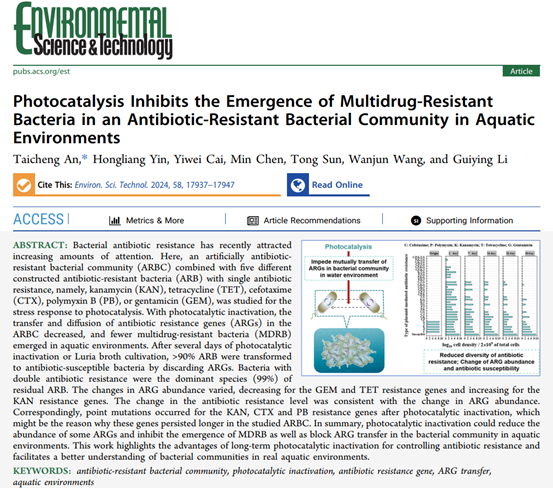《Photocatalysis Inhibits the Emergence of Multidrug-Resistant Bacteria in An Antibiotic-Resistant Bacterial Community in Aquatic Environments》

Website:https://doi.org/10.1021/acs.est.4c06752
Graphical Abstract:
Bacterial antibiotic resistance has recently attracted increasing amounts of attention. Here, an artificially antibiotic-resistant bacterial community (ARBC) combined with five different constructed antibiotic-resistant bacteria (ARB) with single antibiotic resistance, namely, kanamycin (KAN), tetracycline (TET), cefotaxime (CTX), polymyxin (PB), or gentamicin (GEM), was studied for the stress response to photocatalysis. With photocatalytic inactivation, the transfer and diffusion of antibiotic resistance genes (ARGs) in the ARBC decreased, and fewer multidrug-resistant bacteria (MDRB) emerged in the aquatic environment. After several days of photocatalytic inactivation or LB cultivation, >90% ARB were transformed to antibiotic-susceptible bacteria by discarding ARGs. Bacteria with double antibiotic resistance were the dominant species (99%) of residual ARB. The changes in ARG abundance varied, decreasing for the GEM and TET resistance genes and increasing for the KAN resistance genes. The change in the antibiotic resistance level was consistent with the change in ARG abundance. Correspondingly, point mutations occurred for the KAN, CTX and PB resistance genes after photocatalytic inactivation, which might be the reason why these genes persisted longer in the studied ARBC. In summary, photocatalytic inactivation could reduce the abundance of some ARGs and inhibit the emergence of MDRB as well as block ARG transfer in the bacterial community in the aquatic environment. This work highlights the advantages of long-term photocatalytic inactivation for controlling antibiotic resistance and facilitates a better understanding of bacterial communities in real aquatic environments.